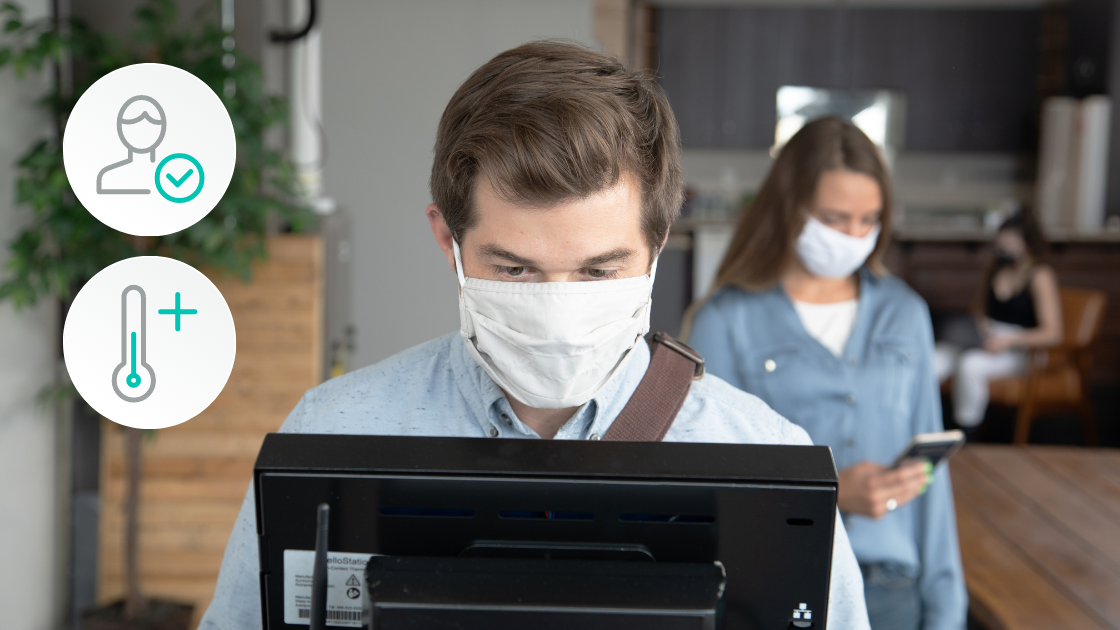Since 2014, Wello has had the same mission—to stop the spread of contagious illness and set a new standard in employee health and safety. Whether in the midst of a global pandemic or business as usual, Wello clients consistently look to Wello to lead the way in building technology and tools meant to protect their people (staff, communities, patients, and families) from the spread of illness. One of the most efficient and proven methods of doing so has been health screening, specifically temperature screening.
Although once controversial, since the start of the Covid-19 pandemic the CDC has recommended and continues to recommend that employers conduct health screening in the workplace. When considering that public health experts say Covid-19 is likely to become a seasonal illness like the flu due to variants and vaccine hesitation, and fever being the leading indicator of contagiousness, it’s easy to understand why.
In this post, we will review reasons the CDC recommends companies continue symptom and temperature screenings to help spot contagious individuals and prevent outbreaks, not just of Covid-19, but of any infectious illness.
Temperature screening effectively identifies contagiousness.
This is perhaps the most important point: The goal of symptom screening, in particular temperature screening, is NOT to diagnose an individual with an infectious illness. In fact, it is entirely likely that a person who might test positive for an illness might not display an elevated temperature at all, and that’s okay. Instead, the goal of symptom screening is to mitigate the risk of an actively contagious person entering your facility and infecting other people. It’s a subtle distinction, but important to understand.
Again and again, scientific evidence points to elevated body temperature, or fever, as the leading indicator of a contagious illness, so by weeding out those with an elevated temperature, companies can isolate those who are most likely to spread a sickness.
Studies have found that viral load, or the amount of virus someone is carrying, is a strong determinant of how contagious a person is. Those with higher viral loads are more likely to spread the virus to other people. In a new CU Boulder study, it was found that only 2% of people carry 90% of the virus that is circulating, meaning the majority of those who test positive for COVID-19 are not the problem in spreading the virus. Instead, a few “super carriers” are responsible for the majority of infections.
When pairing the learnings from these studies with that fact that those with higher viral loads are more likely to have significant immune responses, i.e. fever, it’s clear that employee temperature screening is an effective way to identify the most contagious individuals, and ensure they aren’t in a position to spread to other employees.
Accurate temperature measurement is needed to make screening effective.
Sometimes temperature screening has been cast aside as a “feel good” measure that creates a sense of false security. This is because many thermometers and tablets which are utilized for temperature screening are non-FDA cleared thermal imaging devices and are not accurate in determining someone’s core body temperature. A recent peer-reviewed study showed that many of the mounted tablet devices even employ “normalization algorithms” meant to bring an anomalous body temperature back to normal to avoid false positives. A strong health screening program should be looking for anomalous body temperature, not normalizing (hiding) it, since all it takes is one false negative to turn a day at the office into a “super spreader” event.
Ultimately, a clinically-accurate method of measuring core body temperature is required for body temperature screening to prevent the spread of illness. welloStationX is the only automated, touchless clinical thermometer which is FDA-cleared, making it an effective tool to help prevent the spread of contagious illness in the workplace.
The role of the Hawthorne Effect on infection prevention.
By conducting symptom and temperature screening in the workplace, employees are made aware of employer efforts in reducing the spread of infection as well as expectations for their participation in preventing the spread of infection. This may encourage behavior change as a result of the Hawthorne Effect, a psychological effect characterized by change in behavior as a result of awareness of being observed. Since employees are aware that their symptoms and temperatures are being screened in efforts to minimize the spread of infection, employees may change their behavior to align with the employer’s goal to prevent the spread of infection.
In order for this effect to truly bring about change, it requires a company-wide shift from discouraging absenteeism, to encouraging those who are sick to stay home. Aside from just temperature screening, this culture shift can be accomplished with more paid sick days, removal of punishment for missing work due to illness, and many other tactics.
Temperature and symptom screening help to lower herd immunity threshold.
Since the early days of the pandemic, the term “herd immunity” has been thrown around as the long-sought resolution to the pandemic. Herd immunity is an amount of the population that needs immunity to the virus, either through vaccinations or anti-bodies from previous infection, to make mass spread unlikely.
Initially, experts estimated that 60 to 70 percent of the population would need to gain immunity to the virus in order to meet this threshold. However, in a recent article published in Nature, independent data scientist Youyang Gu said that he believes that reaching a herd immunity threshold is unlikely due to factors such as vaccine hesitancy, the emergence of new variants, and delayed arrival of vaccinations for children. For this reason, Gu, along with many other epidemiologists, have redirected their focus from eliminating the virus completely, and rather, shifted their focus to minimizing deaths and hospitalizations. This can be done by thoughtful efforts to control outbreaks.
Temperature and symptom screening in the workplace can contribute to decreasing the threshold for herd immunity needed to achieve normality and minimize deaths and hospitalizations by preventing the spread of infection.
Symptom and temperature screening is good for long-term public health.
As mentioned, the benefits of temperature screening employees are more than just preventing the spread of Covid-19. It can also help combat the spread of illnesses like the flu, which regularly shut down schools due to outbreaks on a yearly basis. By making symptom and temperature screenings a permanent policy, companies can help prevent outbreaks and ultimately costly shutdowns.


